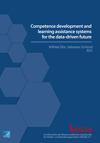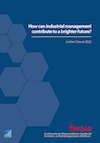Search


Bibtex
Cite as text
@Book{,
Year= "2021",
Volume= "Schriftenreihe der Wissenschaftlichen Gesellschaft für Arbeits- und Betriebsorganisation (WGAB) e.V.",
Pages= "23-36",
Journal = "WGAB",
Title= "This is how we learn A Best Practice Case of Qualification in SMEs for Work 4.0 - A Best Practice Case of Qualification in SMEs for Work 4.0 ",
Author= "M.Sc. Marc Schwarzkopf
Professorship of Ergonomics and Innovation Management Chemnitz University of Technology
Dipl.-Hdl. Dipl.-Kffr. Susann Zeiner-Fink
Professorship of Ergonomics and Innovation Management Chemnitz University of Technology
Prof. Dr. Angelika C. Bullinger-Hoffmann
Professorship of Ergonomics and Innovation Management Chemnitz University of Technology
",
Doi= "https://doi.org/10.30844/wgab_2021_2",
Abstract= "Digitalization is forcing small and medium-sized enterprises (SMEs) to rethink their work and production processes. Initiated by this process, the organization of production and employees are subject to change. As a result, the job profiles of employees are changing and expanding, as well as the way how knowledge is imparted. Innovative and digitized formats should be integrated into existing training programs and presented in a way that is suitable for use on mobile de-vices. Therefore, suitable and target group-specific teaching/learning formats are needed that support participative methods and digital collaboration.
For this purpose, a digital teaching and learning format for the application area of automotive engineering in SMEs was designed. This prototypical teach-ing/learning format was created and evaluated in an iterative process through the participation of the potential users and taking into account existing usability criteria. The two methods used to evaluate the format were Think-Aloud and focus group, the results of this evaluations are presented in this paper. The results show that when evaluating the teaching/learning format, the test subjects mainly refer to the usability criteria of DIN ISO 9241-110, the structure of the course and the information content of the course. Recommendations for the creation of future digital teaching and learning formats for SMEs are derived from these findings.
",
}
M.Sc. Marc Schwarzkopf
Professorship of Ergonomics and Innovation Management Chemnitz University of Technology
Dipl.-Hdl. Dipl.-Kffr. Susann Zeiner-Fink
Professorship of Ergonomics and Innovation Management Chemnitz University of Technology
Prof. Dr. Angelika C. Bullinger-Hoffmann
Professorship of Ergonomics and Innovation Management Chemnitz University of Technology(2021): This is how we learn A Best Practice Case of Qualification in SMEs for Work 4.0 - A Best Practice Case of Qualification in SMEs for Work 4.0 . Schriftenreihe der Wissenschaftlichen Gesellschaft für Arbeits- und Betriebsorganisation (WGAB) e.V.(2021), S. 23-36. Online: https://doi.org/10.30844/wgab_2021_2 (Abgerufen 13.11.25)
Open Access
Abstract
Abstract
Digitalization is forcing small and medium-sized enterprises (SMEs) to rethink their work and production processes. Initiated by this process, the organization of production and employees are subject to change. As a result, the job profiles of employees are changing and expanding, as well as the way how knowledge is imparted. Innovative and digitized formats should be integrated into existing training programs and presented in a way that is suitable for use on mobile de-vices. Therefore, suitable and target group-specific teaching/learning formats are needed that support participative methods and digital collaboration. For this purpose, a digital teaching and learning format for the application area of automotive engineering in SMEs was designed. This prototypical teach-ing/learning format was created and evaluated in an iterative process through the participation of the potential users and taking into account existing usability criteria. The two methods used to evaluate the format were Think-Aloud and focus group, the results of this evaluations are presented in this paper. The results show that when evaluating the teaching/learning format, the test subjects mainly refer to the usability criteria of DIN ISO 9241-110, the structure of the course and the information content of the course. Recommendations for the creation of future digital teaching and learning formats for SMEs are derived from these findings.
Keywords
Schlüsselwörter
References
Referenzen
.

 Deutsch
Deutsch
